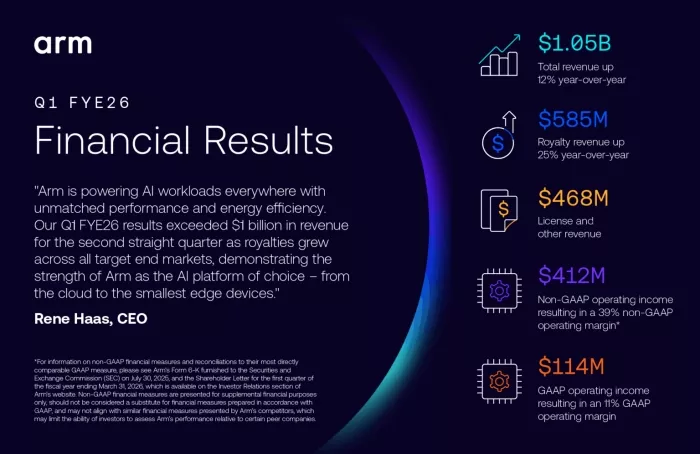Arm Q1 FYE26 Revenue Exceeds $1 Billion for Second Consecutive Quarter
July 31, 2025 -- Today Arm (NASDAQ:ARM) published a letter to its shareholders containing the company’s results for its first quarter of fiscal year 2026 ended June 30, 2025. The infographic below provides the key highlights:

Here are what the results mean and how they were achieved:
- Record revenues for an Arm first quarter, crossing the $1 billion quarterly revenue milestone for the second consecutive quarter and delivering the second-best revenue quarter ever.
- Royalty revenue rose 25% year-over-year to $585 million, driven by the growing adoption of the Armv9 architecture, increasing number of chips based on Arm Compute Subsystems (CSS), and use of Arm-based chips in datacenters.
- From smart sensors in homes and factories to the world’s most advanced AI supercomputers, Arm is the only compute platform architected to deliver AI across the full spectrum of power and performance – from milliwatts to megawatts.
- CSS is reducing time-to-market and development costs for Arm’s partners who are shipping Arm CSS in volume:
- Following the launch of Arm Zena CSS for automotive markets, Arm has already secured its first design win and is actively engaged with more than a third of global automotive OEMs. Zena CSS builds on the success of the Arm automotive platform that is used as the compute foundation for nearly every global OEM today, including Tesla, Rivian, NIO, Mercedes-Benz, Honda, and Geely, among many others.
- Additionally, during the quarter, Arm signed three additional CSS licenses, two for datacenter chips and one for PCs, which means Arm now has 16 CSS licenses with 10 companies, in total.
- According to Arm estimates, at least 70,000 enterprises are now running datacenter workloads on Arm Neoverse-based chips, representing a 14x increase since 2021. Additionally, during the quarter, NVIDIA announced that both Google and Microsoft are deploying hundreds of thousands of Arm-based Grace Blackwell AI superchips across their datacenters to boost performance and efficiency, with AWS, Google, Microsoft, OpenAI, Oracle, and others running production workloads on this infrastructure today.
- Leading smartphone OEMs are adopting the Arm mobile platform across their devices and silicon:
- Xiaomi’s new XRING O1 silicon incorporates the latest Arm CSS platform for mobile;
- Samsung’s Galaxy Flip 7 is based on the Exynos 2500 chipset, which is built on the latest Arm CSS platform for mobile; and
- A major smartphone OEM signed an agreement for multiple future generations of Arm’s GPUs to accelerate graphics and AI in their flagship smartphones through 2030.
- A lead Arm customer has already taped out the first chip built on the Arm Ethos-U85 NPU, which combines high levels of performance and energy efficiency to accelerate edge AI workloads and enable powerful AI use cases, like enhanced image recognition, for IoT applications.
- Already available on the latest iOS devices, Arm Scalable Matrix Extension (SME2), a set of advanced matrix multiplication instructions, will be built into next-generation Android mobile devices for accelerated AI workloads on Armv9 CPUs, like 6x faster AI responses for on-chat interactions with the Google Gemma 3 model. SME2 is built into software stacks via extensive Arm KleidiAI integrations with leading frameworks, so developers automatically access AI performance and efficiency benefits for their apps with no code rewrites needed.
- Arm’s leadership in AI is amplified by a world-leading ecosystem featuring over 22 million software developers building on Arm, which represents more than 80 percent of the global total, and 9 million apps running on Arm.
The full letter to shareholders is available on the Arm investor relations website (https://investors.arm.com/financials/quarterly-annual-results). Information about the Arm earnings conference call can be found here.
Related Semiconductor IP
- Ultra-Low-Power LPDDR3/LPDDR2/DDR3L Combo Subsystem
- Parameterizable compact BCH codec
- 1G BASE-T Ethernet Verification IP
- Network-on-Chip (NoC)
- Microsecond Channel (MSC/MSC-Plus) Controller
Related News
- Arm Q2 FYE26 revenue surpasses $1 billion for third consecutive quarter
- M31 Technology: Q1 EPS NT$2.24, Up 75% YoY, Revenue Growth for the 19th Consecutive Month
- Electronic System Design Industry Logs $4 Billion in Revenue in Q1 2023, ESD Alliance Reports
- M31 Q1 Revenue Increases 9.3% YoY, Advanced Processes Drive QoQ Growth
Latest News
- Keysight Accelerates Electronic Design Productivity with Secure AI-Powered Assistants
- DI3CM-HCI, A High-Performance MIPI I3C Host Controller IP Core for Next-Generation Embedded Designs
- IntoPIX Delivers Real-Time, Low-Power Video Technologies At CES 2026
- Access Advance and Via Licensing Alliance Announce HEVC/VVC Program Acquisition
- Efficient Computer Launches Electron E1 Evaluation Kit to Accelerate Energy-Efficient Computing